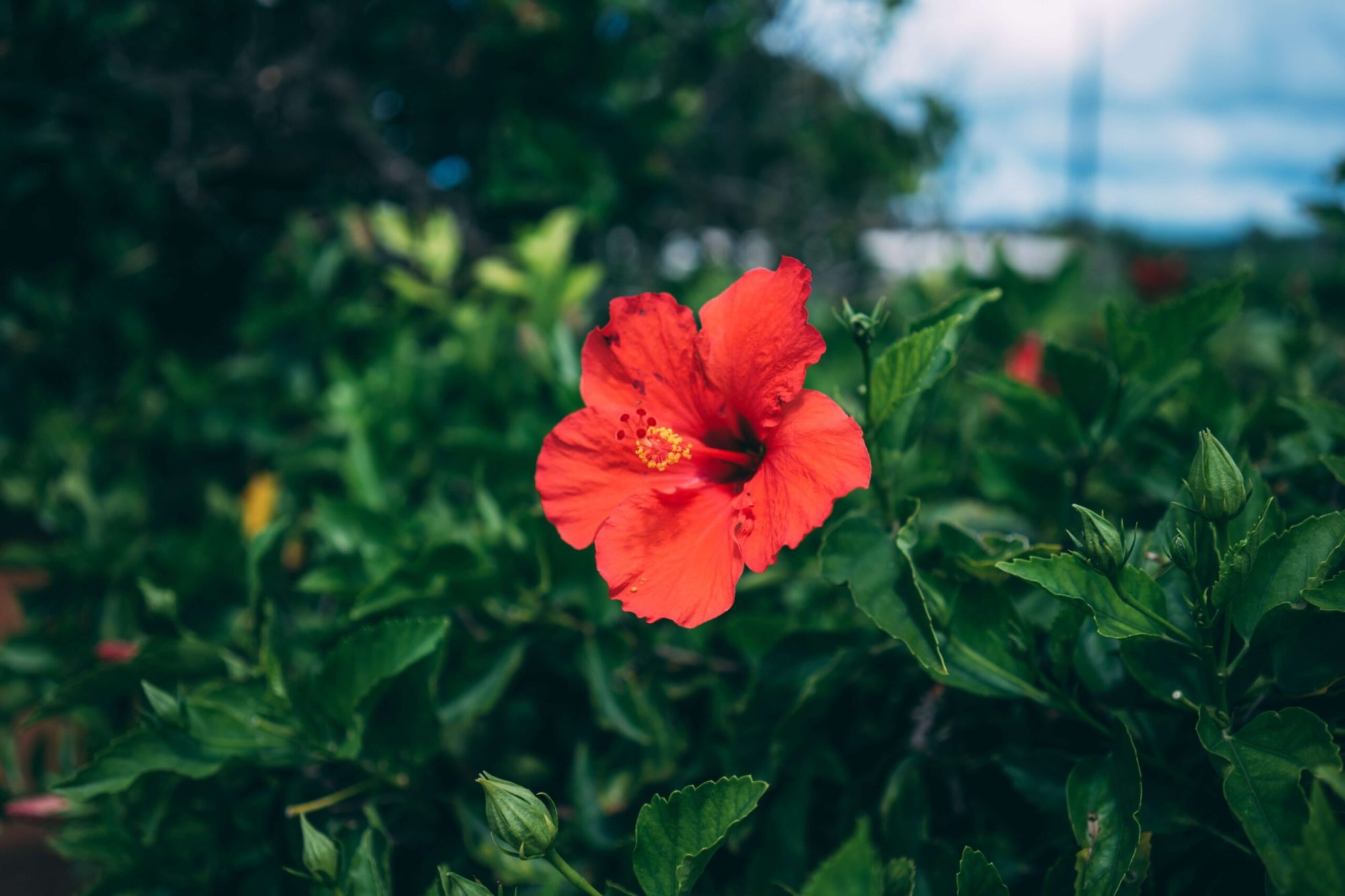THE HIBISCUS: A GUIDE TO HAWAII’S STATE FLOWER

The Hibiscus is a captivating flower that holds a significant place in the heart of Hawaii. As the state flower, it represents the beauty, culture, and vibrant spirit of the islands. In this blog post, we will delve into the enchanting world of the Hibiscus, exploring its origins, varieties, symbolism, and the profound impact it has on Hawaii’s rich heritage. While Hawaii is home to many other amazing flowers, the Hibiscus holds a special spot.
Join us on this journey as we uncover the wonders of Hawaii’s beloved state flower, the Hibiscus.
Hibiscus In Hawaii
Hawaiian hibiscus comprises a distinguished group of seven native species, with the yellow hibiscus being the state flower.
While the non-native Chinese hibiscus and its hybrids dominate ornamental plantings in Hawaii, the native Hibiscus arnottianus occasionally finds its place in gardens.
The Chinese hibiscus offers a wide array of hybrid varieties, captivating with its striking blooms and lush foliage. By incorporating both native and non-native hibiscus species, one can create stunning landscapes that celebrate Hawaii’s unique heritage while embracing the creative possibilities offered by horticultural innovations.
Hawaii’s Yellow Hibiscus: The State Flower
The yellow hibiscus is Hawaii’s official state flower, also known as hibiscus brackenridgei.
What is the Yellow Hibiscus called in Hawaii?
The yellow hibiscus is called the “pua mao hau hele” or “Ma’o hau hele” in Hawaiian.
What does Hawaiian Hibiscus look like?
The hibiscus flowers are strikingly large, with a prominent yellow color and some featuring a vivid red center. They measure around four to six inches in diameter, with certain varieties even reaching an impressive twelve inches in diameter.
The flowers showcase a staminal tube that encloses a slender style, enhancing their unique structure.
Is the hibiscus flower native to Hawaii?
The Hawaiian Islands have a total of 5 hibiscus species that were native to the islands.
How big does Hawaiian hibiscus get?
At full growth, the plant can reach a height of 8 to 16 feet and a width of 5 to 10 feet. The good news is that it doesn’t require much effort to achieve this size. They tend to be one of the easier plants to grow.
Do hibiscus flowers & plants prefer sunlight or dark areas?
Hibiscus flowers prefer sunlight over dark environments.
Medicinal Uses Of Hibiscus
In addition to its aesthetic charm, hibiscus flowers have been utilized for centuries for their potential health benefits, particularly in addressing various minor ailments.
The petals and extracts of the hibiscus plant have been traditionally employed to alleviate stomach issues, stimulate appetite, and provide relief from common cold symptoms.
Furthermore, the hibiscus is known for its anti-inflammatory properties, which may aid in reducing swelling and discomfort. Studies have also suggested that hibiscus consumption could contribute to maintaining healthy blood pressure levels.
While it is important to note that hibiscus remedies are not meant to replace medical advice or treatment, incorporating hibiscus into one’s diet or trying hibiscus-based natural remedies may offer a gentle and supportive approach to managing certain small health concerns.
As always, consulting a healthcare professional is advisable before trying natural remedies.
The Diversity Of The Hibiscus Flower
The hibiscus family encompasses a remarkable array of species, boasting an astonishing diversity that captivates botanists, horticulturists, and flower enthusiasts alike. From tropical regions to temperate climates, hibiscus species can be found in various parts of the world, each exhibiting unique characteristics and charms.
- Hibiscus rosa-sinensis: Commonly referred to as the Chinese hibiscus, this species is celebrated for its large, showy flowers and lush foliage. With a seemingly endless palette of colors and intricate petal formations, the Hibiscus rosa-sinensis captivates with its striking beauty.
- Hibiscus syriacus: Known as the Rose of Sharon, this hibiscus species originates from East Asia. It features an abundance of elegant, bell-shaped flowers that come in hues ranging from white and pink to violet and blue. The Rose of Sharon adds grace and charm to gardens, enhancing their allure.
- Hibiscus sabdariffa: Recognized for its culinary and medicinal applications, Hibiscus sabdariffa, also called Roselle, produces vibrant red calyces that are used to make tart and refreshing herbal teas. This species is valued for its potential health benefits and is widely cultivated in many regions.
- Native Hibiscus (Hibiscus kokio): Endemic to the Hawaiian Islands, the native hibiscus species are highly treasured for their connection to the local culture and environment. With their delicate flowers in shades of red, yellow, or orange, these hibiscus species embody the spirit of Hawaii’s unique biodiversity.
- Hibiscus mutabilis: Known as the Confederate rose or the Cotton rose, this hibiscus species showcases an intriguing characteristic – its flowers change color throughout the day. Blooming as white or pale pink in the morning, the flowers gradually transform into deep pink or red tones by the afternoon, adding a touch of enchantment to any garden.
These are just a few examples of the multitude of hibiscus species that exist worldwide. Each species possesses its own distinctive features, growth habits, and environmental preferences.
From giant dinner-plate-sized blooms to petite blossoms to tropical varieties to hardy hybrids, the diversity within the hibiscus family ensures that there is a perfect hibiscus species to suit every climate and garden style.
Symbolism and Cultural Significance
The Hibiscus holds deep cultural significance in Hawaiian traditions. It symbolizes beauty, grace, and hospitality, and its presence is seen throughout the islands, adorning gardens, landscapes, and even traditional attire. The Hibiscus flower is often worn behind the ear, with different sides representing relationship status: the right side for those in search of love and the left side for those already taken.
This beautiful bloom also serves as a symbol of respect and admiration for the natural beauty of the Hawaiian Islands.
Fun Facts About Hibiscus
- Edible Delights: Hibiscus buds and flowers offer more than just visual appeal. They are edible, featuring a tangy lemony taste, and are packed with vitamin C, adding a refreshing twist to culinary creations.
- Fleeting Beauty: While a hibiscus flower’s beauty is transient, with an average lifespan of just one day, it gracefully remains open throughout the entirety of that day without requiring water. Each blossom becomes a fleeting moment of natural splendor.
- pH Indicator: Surprisingly, a hibiscus flower can be used as a natural indicator of pH in liquids. By placing a hibiscus flower in a liquid, its color will change, providing a visual clue about the liquid’s acidity or alkalinity.
- Nature’s Palette: The vibrant and colorful hibiscus flowers have long been utilized as a source of natural dye. From soft pastels to bold hues, hibiscus petals possess the power to infuse fabrics, yarns, and other materials with eye-catching colors, adding a touch of nature’s vibrancy to artistic creations.
How To Grow Your Own Outdoor Hibiscus
To ensure optimal growth, it is recommended to plant the hibiscus in soil that has good drainage. Pruning should be done sparingly, limiting it to once or twice a year. It is important to remember that hibiscus flowers bloom on new growth, so excessive pruning can hinder flower production.
When exposed to a day or two of frost or freezes, outdoor hibiscus plants should be protected by covering them with a sheet of frost cloth. By following these care guidelines, you can help your hibiscus thrive and enjoy its beautiful blooms. It’s also key to protect your hibiscus flowers from Hawaii’s insects!
The Hibiscus & Hawaii Are Special
The Hibiscus, Hawaii’s state flower, serves as a captivating symbol of the islands’ natural beauty and cultural richness. With its vibrant colors, rich history, and diverse varieties, the Hibiscus enchants visitors and locals alike.
From gardens to festivities, this flower is deeply intertwined with Hawaiian culture and traditions. By appreciating and nurturing the Hibiscus, we can celebrate the allure of Hawaii and create lasting connections with nature.
Join Us At Koloa Zipline!
As you immerse yourself in the wonders of Hawaii’s native hibiscus and its rich cultural significance, why not take your exploration to new heights? Experience the thrill of ziplining through the lush landscapes of Kauai with Koloa Zipline, where adventure meets the beauty of Hawaii’s natural treasures.
Book your zipline tour with Koloa Zipline today and embark on an unforgettable adventure that combines the thrill of flying through the skies with the chance to encounter Hawaii’s native hibiscus in its natural habitat.
